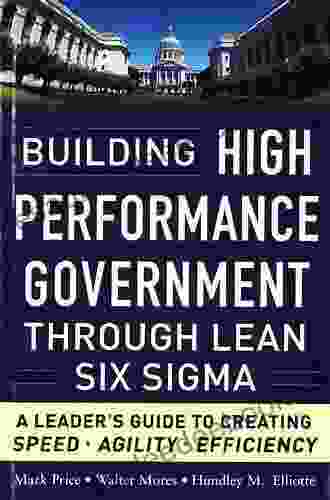The Leader's Guide to Creating Speed, Agility, and Efficiency

In today's fast-paced business environment, organizations need to be able to move quickly, adapt to change, and operate efficiently to stay ahead of the competition. As a leader, it is your responsibility to create a culture of speed, agility, and efficiency within your organization.
This guide will provide you with a step-by-step plan for creating a culture of speed, agility, and efficiency within your organization. You will learn how to:
- Assess your organization's current state of speed, agility, and efficiency
- Identify areas for improvement
- Develop and implement a plan for improvement
- Measure your progress and make adjustments as needed
Step 1: Assess Your Organization's Current State of Speed, Agility, and Efficiency
4.5 out of 5
| Language | : | English |
| File size | : | 2378 KB |
| Text-to-Speech | : | Enabled |
| Screen Reader | : | Supported |
| Enhanced typesetting | : | Enabled |
| Word Wise | : | Enabled |
| Print length | : | 228 pages |
| Paperback | : | 47 pages |
| Item Weight | : | 2.57 ounces |
| Dimensions | : | 5.83 x 0.11 x 8.27 inches |
The first step to improving your organization's speed, agility, and efficiency is to assess your current state. This can be done by conducting a self-assessment or by hiring a consultant to conduct an assessment for you.
The assessment should focus on the following areas:
- Speed: How quickly can your organization move from idea to execution?
- Agility: How well can your organization adapt to change?
- Efficiency: How well does your organization use its resources?
The assessment should also identify any areas where your organization is falling short. Once you have a clear understanding of your organization's current state, you can begin to develop a plan for improvement.
Step 2: Identify Areas for Improvement
Once you have assessed your organization's current state, you need to identify areas for improvement. This can be done by looking at the results of your assessment and by talking to your employees.
Some common areas for improvement include:
- Lack of clear goals and objectives: Employees need to know what they are working towards in order to be productive. If your organization's goals and objectives are not clear, it will be difficult for employees to move quickly and efficiently.
- Inefficient processes: Inefficient processes can slow down your organization and make it difficult to adapt to change. Identify any processes that are not working well and develop plans to improve them.
- Lack of communication and collaboration: Poor communication and collaboration can lead to mistakes, delays, and rework. Improve communication and collaboration by creating open channels of communication and by encouraging employees to work together.
- Lack of training and development: Employees need to have the skills and knowledge they need to be productive. If your employees are not properly trained, they will not be able to move quickly and efficiently.
- Lack of empowerment: Employees need to be empowered to make decisions and take risks. If your employees are not empowered, they will be hesitant to move quickly and adapt to change.
Step 3: Develop and Implement a Plan for Improvement
Once you have identified areas for improvement, you need to develop and implement a plan for improvement. This plan should include specific goals, objectives, and timelines.
Some tips for developing a plan for improvement include:
- Get buy-in from your employees: It is important to get buy-in from your employees before implementing any changes. This will help to ensure that the changes are successful.
- Set realistic goals: Do not try to change too much too quickly. Start by setting realistic goals that you can achieve within a reasonable timeframe.
- Develop a timeline: Once you have set your goals, develop a timeline for achieving them. This will help you to stay on track and make progress.
- Monitor your progress: Once you have implemented your plan, it is important to monitor your progress. This will help you to identify any areas where you need to make adjustments.
Step 4: Measure Your Progress and Make Adjustments as Needed
Once you have implemented your plan, it is important to measure your progress. This will help you to identify any areas where you need to make adjustments.
Some tips for measuring your progress include:
- Use metrics: Use metrics to track your progress towards your goals. This will help you to see how you are ng and make adjustments as needed.
- Get feedback from your employees: Get feedback from your employees on how the changes are working. This will help you to identify any areas where you need to make adjustments.
- Be willing to make changes: Do not be afraid to make changes to your plan if they are not working. The best plans are those that are constantly evolving and adapting.
Creating a culture of speed, agility, and efficiency is essential for success in today's business environment. By following the steps outlined in this guide, you can create an organization that is able to move quickly, adapt to change, and operate efficiently.
4.5 out of 5
| Language | : | English |
| File size | : | 2378 KB |
| Text-to-Speech | : | Enabled |
| Screen Reader | : | Supported |
| Enhanced typesetting | : | Enabled |
| Word Wise | : | Enabled |
| Print length | : | 228 pages |
| Paperback | : | 47 pages |
| Item Weight | : | 2.57 ounces |
| Dimensions | : | 5.83 x 0.11 x 8.27 inches |
Do you want to contribute by writing guest posts on this blog?
Please contact us and send us a resume of previous articles that you have written.
 Book
Book Text
Text Story
Story Genre
Genre Reader
Reader Library
Library Paperback
Paperback Newspaper
Newspaper Preface
Preface Annotation
Annotation Footnote
Footnote Manuscript
Manuscript Scroll
Scroll Codex
Codex Tome
Tome Bestseller
Bestseller Biography
Biography Memoir
Memoir Reference
Reference Encyclopedia
Encyclopedia Dictionary
Dictionary Thesaurus
Thesaurus Narrator
Narrator Librarian
Librarian Catalog
Catalog Card Catalog
Card Catalog Stacks
Stacks Archives
Archives Periodicals
Periodicals Study
Study Scholarly
Scholarly Lending
Lending Academic
Academic Journals
Journals Reading Room
Reading Room Special Collections
Special Collections Dissertation
Dissertation Reading List
Reading List Book Club
Book Club Theory
Theory Linda C Wolstenholme
Linda C Wolstenholme John O Kane
John O Kane Janet Majerus
Janet Majerus Margie Miklas
Margie Miklas Monica R Miller
Monica R Miller Jennifer Brown
Jennifer Brown Jeanette Farrell
Jeanette Farrell Alex Kuczynski
Alex Kuczynski Juliet Petrus
Juliet Petrus Marilyn Nonken
Marilyn Nonken Jf Lee
Jf Lee Star Edwards
Star Edwards Juanita Ray
Juanita Ray Sergio Troncoso
Sergio Troncoso John Shirley
John Shirley Alex Thomas Davis
Alex Thomas Davis David Boe
David Boe Jackie French
Jackie French John Saunders
John Saunders Gary Y Okihiro
Gary Y Okihiro
Light bulbAdvertise smarter! Our strategic ad space ensures maximum exposure. Reserve your spot today!

 Ross NelsonUnveiling the Enigmatic Depths of Agatha Christie's Masterpiece: Five Little...
Ross NelsonUnveiling the Enigmatic Depths of Agatha Christie's Masterpiece: Five Little... Truman CapoteFollow ·15.7k
Truman CapoteFollow ·15.7k Bruce SnyderFollow ·14.3k
Bruce SnyderFollow ·14.3k Gene SimmonsFollow ·14.1k
Gene SimmonsFollow ·14.1k Jayden CoxFollow ·6.8k
Jayden CoxFollow ·6.8k Jesus MitchellFollow ·8.8k
Jesus MitchellFollow ·8.8k Brenton CoxFollow ·16.3k
Brenton CoxFollow ·16.3k Seth HayesFollow ·8.9k
Seth HayesFollow ·8.9k Henry HayesFollow ·13k
Henry HayesFollow ·13k

 Gary Reed
Gary ReedWeb to Web for Beginners: A Comprehensive Guide to...
In today's interconnected world, websites...

 Elliott Carter
Elliott CarterThe Moon Is Down: John Steinbeck's Poignant Portrait of...
In the annals of literature, John...

 Dalton Foster
Dalton FosterMark The Mechanic: The Incredible Story Of A Young...
In the vibrant realm of robotics, where...

 Fred Foster
Fred FosteriPhone 13 Pro Max User Guide: Everything You Need to Know
The iPhone 13 Pro Max...

 Rodney Parker
Rodney ParkerPope John Paul II: The Pocket Giant Who Inspired Millions
Pope John Paul II, or...
4.5 out of 5
| Language | : | English |
| File size | : | 2378 KB |
| Text-to-Speech | : | Enabled |
| Screen Reader | : | Supported |
| Enhanced typesetting | : | Enabled |
| Word Wise | : | Enabled |
| Print length | : | 228 pages |
| Paperback | : | 47 pages |
| Item Weight | : | 2.57 ounces |
| Dimensions | : | 5.83 x 0.11 x 8.27 inches |









